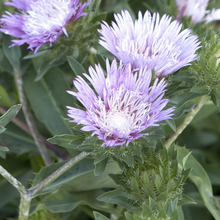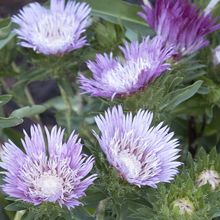Stokesia 'Colorwheel' is a unique cultivar of Stokes' Aster prized for its extraordinary multicolored blooms that open white and gradually transition through pale lavender, pink, and finally deep purple all on the same flower head. These long blooming, daisy like flowers appear over sturdy compact mounds of evergreen basal foliage and are excellent for both garden display and cut arrangements. It thrives in heat and humidity and performs well in southern gardens where many asters struggle.
Height & Spread: 12 - 18 in x 12 - 18 in
Bloom Time: June to September
Light Requirements: Full sun to part shade
Soil Preference: Well drained, slightly acidic to neutral soil
Watering Needs: Average; allow topsoil to dry slightly between watering
Deer Resistance: Rarely browsed due to tough foliage and bitter compounds
Native Status
Stokesia laevis is native to the southeastern United States, particularly in coastal plains and pine savannas, making it well suited to native and pollinator gardens in those regions.
WILDLIFE & INSECTS
Bees
- Highly attractive to a wide range of native bees including sweat bees and bumblebees for its abundant pollen.
Butterflies
- Frequented by Monarchs, Painted Ladies, and Swallowtails due to its long bloom season and nectar rich blooms.
Beneficial Insects
- Encourages ladybugs and hoverflies that help control aphids and other garden pests.
Spacing & Landscape Use
Spacing Recommendations:
- Space 12 - 18 inches apart to allow mounded growth habit to develop fully and maintain airflow.
Landscape Placement:
- Perfect for borders, butterfly gardens, and massed plantings where a tapestry of color change can be appreciated.
Companion Plants
- Coreopsis verticillata 'Moonbeam' - Airy texture and lemon yellow flowers echo the brightness of Stokesia blooms.
- Erigeron speciosus (Showy Fleabane) - Light purple, daisy like blooms complement the changing hues of 'Colorwheel'.
- Allium schoenoprasum (Chives) - Rounded purple flower heads mirror the form of Stokesia and attract beneficial insects.
- Echinacea purpurea 'Magnus' - Upright form and rich pink flowers create layered contrast and attract similar pollinators.
- Salvia nemorosa 'Caradonna' - Violet blue spikes provide vertical structure and pair well in sunny borders.



